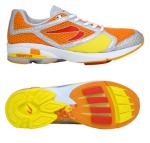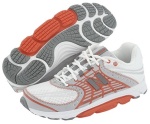While “Barefoot” Running shoes may be an oxymoron, For most of us it is better to run with them than without em.
I am aware of 6 different shoes being marketed as Barefoot Running shoes. (see below)
Also – the website www.barefootrunningshoes.org has great information on a number of the barefoot running shoes available .
#1 Vibram Fivefingers www.vibramfivefingers.com (Great website for info about their shoes)
I love the pair of FiveFingers KSO’s (Keep Stuff Out) that I have.
#2 Newton Running shoes www.newtonrunning.com(great website for info about thier shoes)
#3 New Balance 800’s www.newbalance.com (not very helpful website if you are looking for information about these shoes – click on the “Chi running” link at the bottom of the page for the limted amount of info about these shoes they have)
#4 Feelmax Osma www.feelmax.com (the Osma is featured on the home page. I could find any info about it on the website. Barefoot Ted tested a pair of Feelmax shoes [not the Osma] and he liked them)
#5 Nike Free www.nike.com (given the amount of cushion in the heel, these shoes do not strike me as true Barefoot running shoes, you will have to decide for yourself.)
#6 Terra Plana Vivo Barefoot shoes www.terraplana.com/vivobarefoot (please note cetain styles of the Vivo Barefoot Shoes are meant for running like the Evo www.terraplana.com/evo
I will be glad to run in and review any pair of Barefoot Running shoes that Any manufacturer or retailers who would like send to me. 🙂
As far as Tips for Barefoo running found the post Beginners Guide to Barefoot Running found at www.Barefoot-running.us to be helpful. The specific article I am referring too is here- www.barefoot-running.us/beginners-guide-to-barefoot-running
I found this information from Harvard science to be helpful as well-
www.barefootrunning.fas.harvard.edu/5BarefootRunning&TrainingTips
From Harvard Science-
“Tips on Proper Forefoot or Midfoot Strike Form
There is no single “perfect running form.” Everyone’s body is different and no single technique could be best for everyone. Here are some general tips:
- A good landing should feel gentle, relaxed and compliant. You typically land on the ball of your foot towards the lateral side. After the front of your foot lands, let the heel down gradually, bringing the foot and lower leg to a gentle landing as you dorsiflex your ankle under the control of your calf muscles. It’s like when you land from a jump, flexing the hip, knee and ankle. Again, the landing should feel soft, springy, and comfortable. It’s probably good to land with the foot nearly horizontal so you don’t have to work the calves too much.
- Do not over stride (land with your foot too far in front of your hips). Over striding while forefoot or midfoot striking requires you to point your toe more than necessary, adding stress to the calf muscles, Achilles tendon, and the arch of the foot. It often feels as if your feet are striking the ground beneath your hips. In this respect it feels like “running in place” (as runners sometimes do when waiting to cross a street). It is also similar to the way one’s feet land when skipping rope.
- A good way to tell if you are landing properly is to run totally barefoot on a hard, smooth surface (e.g. pavement) that is free of debris. Sensory feedback will quickly tell you if you are landing too hard. If you run barefoot on too soft a surface like a beach, you might not learn proper form.”
My other Barefoot Running related posts are
Running Shoes Damage Your Feet – Run Barefoot (Insanity! or Maybe Not)
Barefoot Running Websites – 5 Interesting Ones








Steven,
Nice blog. Interesting topics.
The NB 800s might be considered more of a neutral cushioning shoe used in transition to a more minimalist shoe (or barefoot) as technique allows.
Some more minimalist shoe recommendations from the author of ChiRunning:
– http://chirunning.com/blogs/danny/2010/02/07/chirunning-recommendations-for-minimal-shoes
For those not familiar with ChiRunning, here is a short intro video:
– http://www.youtube.com/watch?v=H26liWMDH8U
Enjoy,
David.
I have been a heel-striker for the past two years that I’ve been running and in the last two weeks, have been adjusting to forefoot strikes. The early example of the shock absorber/spring is clarified like this: if your legs are a shock absorber and your leg muscles/tendons/ligaments are the springs, then landing heel-first basically decreases the length of your shock absorber. If your legs are, say, 32″ long, and your foot is about 12″ long, then you could actually have 44″ of shock absorption as opposed to 32″. However, even then, it is not merely length; the foot itself contains much more cushioning ability in the arch, the parts of the foot itself, so in terms of percentages, you are really removing a lot of the natural shock absorption abilities that your body has. for myself, I’ve gotten stronger by running on my forefeet; new muscles are being strengthened that I didn’t use previously. Imagine you are doing calf-raises like in a gym, except you are doing them step-by-step, miles at a time. it is fairly obvious the performance advantage after your legs have built up the strength to support forefoot running. Makes sense, right? And when you look at track sprinters, do they ever land on their heels or are they on their toes?
— Kara from sequin shoes